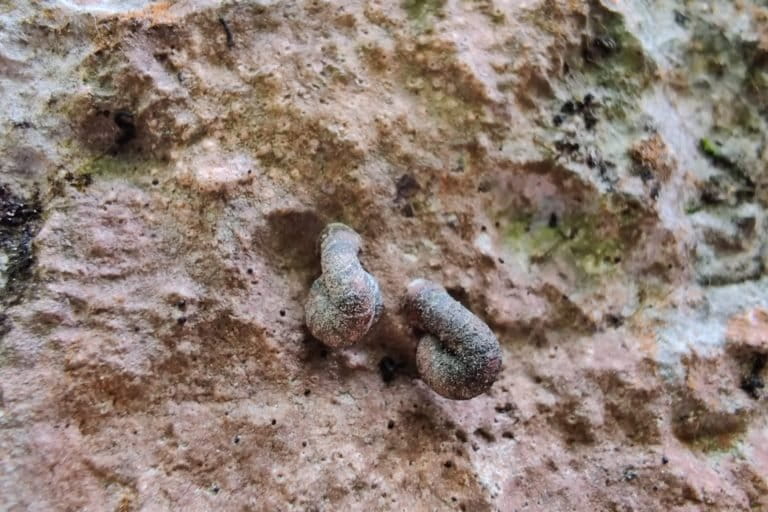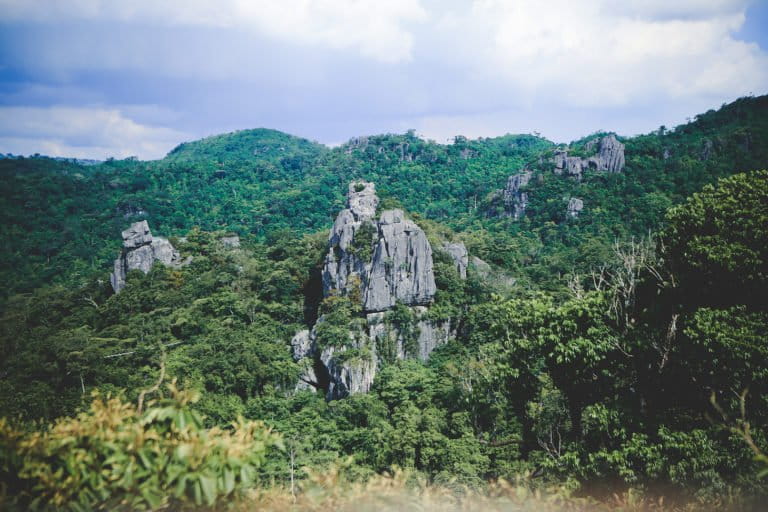- Researchers have discovered a subspecies of a microsnail in a protected area east of the Philippine capital Manila.
- Hypselostoma latispira masungiensis is no bigger than an ant and is notable for inverting its shell when resting, unlike other snail species.
- Like many other snails, l. masungiensis thrives on karst formations, but its habitat in Masungi Georeserve has been the target of limestone quarrying companies for years.
- The georeserve is a conservation area where quarrying has been banned since 1993; despite this, three quarrying companies have been operating there since 1998.
MANILA — In 2017, a group of researchers surveying mollusks in a popular ecotourism site east of the Philippine capital stumbled upon a tiny land snail with a unique “upside down shell.”
It was a microsnail, its shell just about the size of an ant, and it was found crawling along the jagged limestone boulders of Masungi Georeserve, looking for lichens and other vegetation to feed on. While the snail carries its shell in a typical position when it moves, with the pointed whorl at the top, when resting in crevices it moves its shell so that the whorl is underneath.

Emmanuel Ryan de Chavez, an associate professor at the University of the Philippines Los Baños (UPLB) and curator of mollusks at the UPLB Museum of National History, and his students were initially unable to identify it. But they later found an old paper describing a similar snail, called Hypselostoma latispira, found 200 kilometers (120 miles) away in upland Baguio City.
“We initially identified the Masungi snail as Hypselostoma latispira,” de Chavez tells Mongabay. The group then went to Baguio City, some 250 km (180 mi) north of Manila, to closely examine the species.
“However, upon further examination of the shell morphometrics and shape, and other taxonomically important characters, the Masungi Hypselostoma is different from the Baguio snail,” de Chavez says.
The Masungi snail was slightly larger (with a shell width of 4.5-5 millimeters, or a fifth of an inch) than the Baguio snail (4.2-4.5 mm). De Chavez says the Masungi snail also has a “more angular shell and the last whorl more oriented upwards.” Unlike the Baguio snail, which only has four aperture teeth or projections in the opening of its shell, the Masungi snail has five.
DNA analysis of the two snails showed 99.98% similarity, which means they’re the same species. But since they’re morphologically different, de Chavez says they’re proposing the discovery as a subspecies.

After three years of morphological and DNA analyses, the findings on Hypselostoma latispira masungiensis by de Chavez and fellow Filipino scientists Harold B. Lipae, Angelique L. Estabillo and Ian Kendrich C. Fontanilla were recently published in the Philippine Journal of Systematic Biology.
De Chavez says the “upside down shell” of the Masungi snail while resting “is usually observed in the same genus.”
“The possible function of this upside down resting position is to protect most of visceral mass or hump of the shell containing most of its internal organs from direct heat. It is also possible that such position is efficient to stabilize body weight by anchoring most of its shell into a crevice,” he says, adding that more studies are needed to validate these hypotheses.
De Chavez says subspecies diverge in their morphology, or physical characteristics, because of geographic isolation and adaptation to different habitats. He says that while both Baguio and the Rizal region where Masungi Georeserve is located are both cool, damp and foggy at certain times of the day, the georeserve has many limestone formations. “Karsts [limestones] are considered habitat islands, thus the genetic connectivity among separated snail populations will be restricted,” he says.
The researchers are looking into several hypotheses about how the snails ended up in Masungi – and their hypotheses get creative: from the snails crawling the long interconnected karst forests, to riding the winds.

“The snails from Baguio City might have used the patches of karst forest in the eastern side of Luzon [the Philippines’ largest island] as ‘stepping stones’ going to Masungi,” de Chavez says. They may have also been transported by strong winds during typhoons or by birds, since snails can sometimes survive digestion, de Chavez says. It might also be possible that the distribution of the snails throughout Luzon was extensive to begin with, but that over time, geological barriers arose and separated the populations, he adds.
De Chavez says that while they aren’t new species, subspecies are very important to note because “they represent a discrete population of biodiversity conservation value.” They may also be later recognized as a new species. De Chavez says subspecies help humans understand how animals adapt to local habitats as they become isolated.
While small, microsnails like H. l. masungiensis are important in ecosystems, serving as prey for birds, monitor lizards and rodents. Some Indigenous groups also use snails for food and medicine, though there’s no research yet on whether this applies to this particular microsnail species.
“They help in forest litter decomposition, and essential in calcium recycling,” de Chavez says. “Because of their specific habitat requirements, snails can serve as indicators of pristine and intact habitats, in both rainforests and karsts.”
As limestones are important for H. l. masungiensis and other snails, quarrying is the prime threat to these snails. “Any destructive extraction and modification of these habitats could compromise their survival, or even result [in] their local extinction,” the researchers say.

Masungi Georeserve is at especially high risk from this threat, being in an area that has in the past been destroyed by illegal logging and quarrying. While it is now an award-winning conservation and ecotourism site, known for its iconic limestone formations and Instagram-worthy rope courses, it was mostly deforested just two decades ago, the result of land grabs.
In February this year, a portion of Masungi Georeserve’s conservation site was blocked off by a quarry company. In a visit to the site, however, Roy Cimatu, the secretary of environment and natural resources, ordered the fences removed and promised that mining will not be allowed in the protected area and watershed.
“Since Secretary Cimatu already gave these orders and the law is indisputable, we are just waiting for the progress update from the concerned offices,” Billie Dumaliang, advocacy officer at Masungi Georeserve Foundation, tells Mongabay.
Dumaliang says that despite this, they are worried that three quarry companies with existing mineral production sharing agreements (MPSA) within the geopark and a nearby critical watershed might be “well-entrenched” with a lot of money. Dumaliang says quarrying in the area has been prohibited since 1993, yet the companies were reportedly able to get permits in 1998. While Dumaliang has yet to receive a copy of the documents, she says the permits might have been “illicitly issued.”
Despite the area’s popularity and successes, “Masungi and surrounding areas continue to be beset by large environmental problems,” Dumaliang says. “We are literally the last green frontier from Metro Manila to the east along the national highway. Especially during the COVID-19 pandemic, there were multiple illegal logging incidents or forced occupations or false claims of forest land by unscrupulous groups or individuals.”

In recent years, more scientific groups have shown interest in doing research in Masungi and its surrounding karst landscape.
Dumaliang says one group found a frog species endemic to the Philippines in Masungi’s limestone pits. “Kaloula kalingensis are typically tree-dwellers so it is quite peculiar that they spend a lot of time inside the pits of limestones. Experts say that they haven’t observed this behavior in other limestone habitats where the K. kalingensis is found,” she says, adding that the frogs are able to match their coloring with the limestone patterns as camouflage.
De Chavez says he believes there are more species and subspecies that have yet to be identified in Masungi, which is recognized as “one of the arks of [mollusk] diversity in Luzon Island.”
“However, we should work double time to look for them as various natural and anthropogenic threats are endangering the survival of these highly sensitive animals,” he says.
Citation:
Lipae, H. B., Estabillo, A. L., Fontanilla, I. K. C., & de Chavez, E. R. C. (2020). A new subspecies of microsnail from Masungi Georeserve, Rizal, Philippines. Philippine Journal of Systematic Biology, 14(3). doi:10.26757/pjsb2020c14003
Related stories:
Banner image of the the Hypselostoma latispira masungiensis. This microsnail subspecies is often found on boulders, feeding on moss, or hiding in crevices. Photo courtesy of the University of the Philippines Los Baños research team.
FEEDBACK: Use this form to send a message to the author of this post. If you want to post a public comment, you can do that at the bottom of the page.
